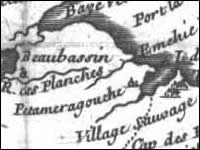


History - Beaubassin (con't)
|
At the time of the deportation, in 1755, the Acadians of Beaubassin were the first to be taken as prisoners, on August 10th 1755. Charles Lawrence, lieutenant governor of the Nova-Scotia, ordered that the first Acadians arrested would be of Beaubassin because of their previous mischief with the English. A large portion of the inhabitants of this region hid in |
|
|
the forests on the advice of their priest, Father LeGuerne, who was warned in advance of the English attack. Two thirds of the population of Beaubassin therefore escaped the deportation. However, many of these Acadians were arrested by the English, and detained in Fort Cumberland, once Beaubassin. But not all Acadians of this region were able to hide in time, because on October 27th, 1755, 1 900 Acadians from Beaubassin were put in ten vessels. Approximately 1000 of these Acadians were deported to North and South Carolina. Most were native of Beaubassin and were left in Charleston. About 400 of Beaubassin's Acadians were deported as far as Georgia because they were guilty of rebellion. By 1758, at the border of the Ristigouche River, at the bottom of the Bay des Chaleurs, were Acadian refugees, most of who were native, either of Beaubassin, Pisiguit, or Grand-Pré. Acadians from Beaubassin who escaped the deportation by hiding in the forest were among the first Acadian families of the region of Saint-Charles-de-Bellechasse. At l'île Saint Jean we also counted numerous families native of Beaubassin. Acadians never had the right to return to Beaubassin, thus the
parish was never rehabilitated after the deportation. At the beginning
of the century, we fortunately found in La Rochelle, France, the
strongest part of Beaubassin's censuses, covering most of the years
between 1712 and 1748. The English remained in the place, which
is best described today as Amherst. |
|
